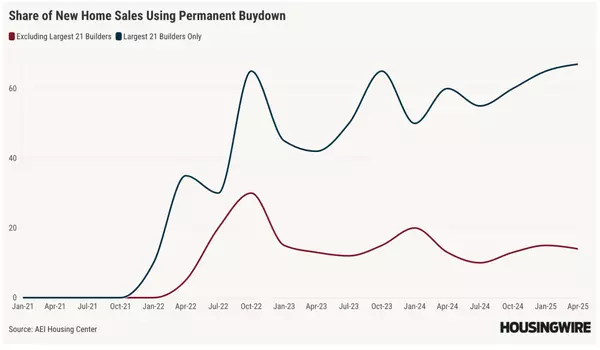FOA maps next steps after PHH reverse asset acquisition

Onity Group, the parent company of PHH Mortgage Corp. and its reverse mortgage arm, Liberty Reverse Mortgage, announced this week that it has chosen to stop originating reverse mortgages. Instead, Onity said it’s selling almost all of its reverse mortgage business to Finance of America (FOA). PHH is
Read MoreCompass welcomes RealTrends Verified Van Volkenburg Virginia-based team

Compass adds the Dianne Van Volkenburg Team to its Great Falls, Va., office — bringing more than 80 years of combined experience in residential and land transactions, subdivision work, acquisitions and new construction. The team is led by Principal and Owner Dianne Van Volkenburg. The 2025 RealTrend
Read MoreUnlisted hopes to unlock more housing inventory

The idea for proptech firm Unlisted came to founder and CEO Katie Hill after she fell in love with a neighbor’s house and approached him about potentially buying it if he ever decided to sell. “It caught my eye and the only thing I could do was walk across the street one day when my neighbor was out
Read MoreCooling home prices, stable inventory as buyers gain leverage

The U.S. housing market continues to show signs of cooling as listing prices ease and inventory levels remain steady, according to most recent HousingWire data. As of Nov. 14, the median list price stood at $429,900, while new listings are entering the market at a median of $395,000. Homes are spend
Read MoreExisting home sales show 4 months of year-over-year growth
Existing home sales posted another positive year-over-year print in October, marking the 4th straight month of year-over-year growth. Earlier in the year, I predicted that existing home sales would perform better than expected amid elevated mortgage rates. Since we were working with some of the lowe
Read MoreDRB Homes launches for-sale housing at Charleston Navy Yard

When South Carolina’s Charleston Naval Shipyard closed in 1996, the decision led to significant job losses and economic shock for the local community. North Charleston spent years crafting redevelopment plans for the 2,800-acre site and its collection of historic buildings. Now, the city is seeing s
Read More-

If we built the mortgage market from scratch, what would it look like?

A system designed for purposeEvery mortgage market is patchwork. Rules, products, and features exist because of past events, a crisis, a policy choice, or a market failure. The result is a structure that reflects history more than design. That doesn’t make it bad, but it does mean we carry baggage t
Read MoreZillow faces new claims in amended RESPA suit

The plaintiffs in the Taylor Real Estate Settlement Procedures Act (RESPA) suit filed against Zillow in mid-September filed an amended complaint on Wednesday. The amended complaint contains testimony from a dozen anonymous current and former Zillow-affiliated loan officers and agents that corrobora
Read MoreWealthfront announces entrance into the mortgage business

Wealthfront, a fintech known for low-cost investing and savings products, is entering the mortgage business. The California-headquartered company announced Wednesday that was offering early access to Wealthfront Home Lending, which offers mortgages through the company’s automated, software-driven pl
Read MoreCape Coral housing market shifts toward buyer conditions as homes sit 119 days

The Cape Coral–Fort Myers-Naples, FL metro housing market has moved into buyer-favorable territory, with homes taking a median 119 days to sell, 54% longer than the national median of 77 days, according to HousingWire Data for the week ending Nov. 14, 2025. Single-family inventory in the Cape Coral
Read MoreCan this immersive technology replace model homes?

Florida-based AR Franchising, the franchisor of the AR Homes brand that includes about 40 franchise custom homebuilders in nine states, rolled out an innovative virtual model home in one of its communities. Earlier this year, the company launched its first in-market AR Theatre within the Tesoro Club
Read MoreBill Ackman’s GSE proposal faces hurdles on capital, Treasury forgiveness

Bill Ackman’s plan to relist Fannie Mae and Freddie Mac faces skepticism over whether the federal government would be willing to forgive billions of dollars in senior preferred investments. Even if it did, uncertainties around capital requirements would still limit share value, according to analysts
Read MoreBack to homebuilding’s basics of doing more with less … faster

In today’s homebuilding economy—where interest rates whiplash buyer demand, costs remain stubbornly high, and affordability pressures crush margins—one truth grows clearer by the month: something’s got to give. That “something” may be the industry’s muscle-memory tolerance for inefficiency—its broke
Read MoreUnlock closes company record $303M HEA securitization

Fintech Unlock Technologies announced on Wednesday the closing of its sixth home equity agreement (HEA) securitization, issued and sponsored by Saluda Grade. The transaction securitized $303 million of HEAs originated and managed by Unlock, marking the company’s largest securitization to date and it
Read MoreSenate banking committee advances nominees to lead FHA, Ginnie Mae

The top leadership positions at Ginnie Mae and the Federal Housing Administration (FHA) have been empty for most of the past year, but the long wait to fill the seats may soon come to an end. On Wednesday, the Senate Committee on Banking, Housing and Urban Affairs advanced the nominations of Joseph
Read MoreGrand Rapids sellers reduce prices on 45% of homes, market moves faster than state

Nearly half of Grand Rapids, MI metro home sellers reduced asking prices during the week ending Nov. 14, 2025, while the market maintained its position as one of Michigan’s fastest-moving housing markets with homes selling 21 days quicker than the state average. The aggressive pricing strategy appea
Read MoreA rising threat to homeownership: How heirs’ property undermines affordable housing

A 2021 NPR podcast segment painted a picture of the American Dream turned Nightmare: a Louisiana family faced the loss of their five-generation-home that had been owned by the family’s great, great, great grandfather, Jacob Loud, who was formerly enslaved. That segment from four years ago is still
Read MoreZillow launches CreditClimb to help renters build credit with every rent payment

Figure unveils industry-first blockchain stock offering

Figure Technology Solutions Inc. filed a registration statement on Monday with the Securities and Exchange Commission (SEC) for a proposed public offering of its Series A Blockchain Common Stock, marking the launch of the first blockchain-native public equity security. Figure‘s offering introduces s
Read More
Categories
Recent Posts










